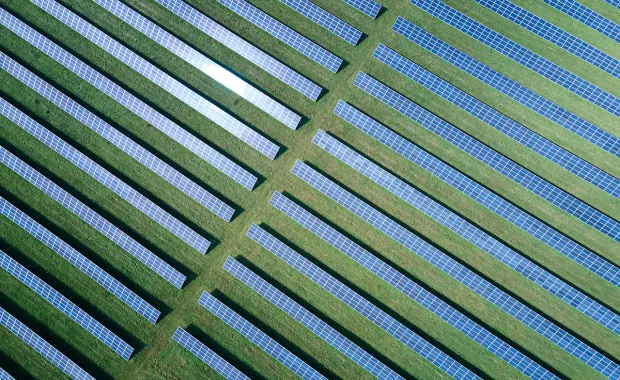The transition towards a more sustainable global economy has elevated the importance of low-carbon hydrogen as a critical and highly relevant issue. Low-carbon hydrogen plays a vital role in driving energy transformation and helping organizations achieve their ambitious net-zero emissions targets for 2030 and 2050. Additionally, the use of low-carbon hydrogen can enhance organizations' energy independence, reducing their reliance on traditional fossil fuel-based energy sources and providing them with a competitive advantage as they adapt to meet the growing demand for sustainable solutions.
As the use of low-carbon hydrogen gives rise to new opportunities, AI is becoming increasingly integral to unlocking possibilities, driving innovation and shaping the future of the low-carbon hydrogen economy.
Evolving opportunities for low-carbon hydrogen in the energy market
Low-carbon hydrogen is poised to play a central role in transforming the energy landscape and enabling organizations to achieve their sustainability goals. Here are some key energy market priorities which low-carbon hydrogen helps address:
- Decarbonization and climate neutrality
Low-carbon hydrogen is produced from renewable energy through the electrolysis of water and generates no carbon emissions during its production and use. By integrating it into the energy chain, it contributes significantly to decarbonization and the goal of achieving climate neutrality by 2050.
- Storage and flexibility
Low-carbon hydrogen is a versatile energy carrier that can be easily stored and transported. It can be used to balance energy supply and demand, especially when renewable sources are intermittent.
- Energy diversification
Low-carbon hydrogen diversifies energy sources. By integrating it into sectors such as industry, mobility and heating, we reduce our dependence on fossil fuels and increase the resilience of the energy system.
- Job creation and economic opportunities
The production, distribution and use of low-carbon hydrogen generates jobs and economic opportunities throughout the value chain. From the installation of electrolyzers to the construction of transportation and storage infrastructure, there is significant potential for economic growth.
- Innovation and technology
Research and development around low-carbon hydrogen is driving technological innovation. This includes improvements in electrolyzer efficiency, safe storage and transportation infrastructure.
- Political and financial support
The EU, the U.S., Canadian and other national governments are committed to low-carbon hydrogen. Strategies and funds have been established for its development and deployment. Their investments in low-carbon hydrogen projects are seen as critical to meeting their successful climate goals and as a key new industry for their economies.
Back to top
The role of AI in advancing the low-carbon hydrogen economy
Artificial intelligence (AI) is becoming increasingly integral to the development of the low-carbon hydrogen ecosystem. There are several areas where AI is supporting and creating new opportunities across the industry:
- Decarbonization and renewable energy
AI can help optimize the integration of renewable energy, such as solar and wind, into the power grid, while advanced algorithms can predict renewable energy generation and adjust demand in real time. AI also enables demand management and prediction of consumption patterns, which are crucial for balancing energy supply and demand and ensuring grid stability.
- Operational efficiency and predictive maintenance
AI can improve the operational efficiency of power plants and distribution networks. By analyzing historical and real-time data, opportunities to optimize production and reduce costs can be identified. AI also enables predictive maintenance via machine learning algorithms that can predict equipment failures before they occur, reducing downtime and associated costs.
- Low-carbon “green” hydrogen and electrolysis
Low-carbon “green” hydrogen is produced by electrolysis of water using renewable electricity. AI can improve the efficiency of this process by optimizing hydrogen production and reducing costs. AI can also help identify optimal locations for electrolysis plants and predict future demand for low-carbon hydrogen.
- Carbon capture, utilization, and storage utilized to produce low-carbon hydrogen
Carbon capture, utilization, and storage (CCUS) can be applied to existing hydrogen production facilities to capture the CO2 and reduce the overall emissions, creating "blue hydrogen" with a much lower carbon footprint.
- Intelligent network management
Smart grids are essential for the transition to a more sustainable energy system. AI can manage the interaction between generators, consumers and energy storage in these grids. Fraud detection and cyber security also benefit from AI in smart grids.
- Regulation and public policy2
AI can help regulators and policy makers make informed decisions. Predictive models can assess the impact of different policies in the utility industry. Transparency and explainability of algorithms are essential to ensure effective and fair regulation.
Back to top
Key challenges low-carbon hydrogen must overcome to drive widespread adoption
The rise of new technologies and innovative applications has underscored the inherent potential of low-carbon hydrogen. However, there remain a few crucial focus areas that require careful consideration.
- Availability of renewables
Low-carbon “green” hydrogen is produced by electrolysis of water using renewable electricity. However, the availability of renewable sources is essential for large-scale production. The challenge lies in ensuring that there is sufficient renewable energy to power electrolysis and produce hydrogen in a sustainable manner.
- Production and maintenance costs
Although costs have decreased, the initial investment in electrolysis plants or CCUS is still significant. In addition, operating and maintenance costs must also be reduced. The industry must find ways to increase efficiency and reduce costs to make low-carbon hydrogen competitive with other energy options.
- Security and scalability
Safety in hydrogen production, storage and transportation is crucial. Rigorous standards and protocols are evolving and need to be adhered to avoid accidents. Hydrogen fuel cell technology is fully developed and is used in industrial sectors such as oil refining, the iron and steel industry, and the chemical industry. Additionally, scalability is essential to meet growing demand. New plants must be able to scale up production efficiently. Renewable hydrogen must become an intrinsic part of an integrated energy system.
The EU plans to install at least 40 GW of electrolyzers by 2030 and produce up to 10 million tons of renewable hydrogen. Short- and long-term energy storage can be achieved using renewable hydrogen as an energy carrier, facilitating the use of existing infrastructures. Low-carbon hydrogen can be gradually incorporated into the gas network, making it possible to take advantage of its infrastructures and increase the integration of the energy sectors.
The U.S. has announced the development of seven Regional Clean Hydrogen Hubs, to kickstart and accelerate the commercial-scale deployment of low-carbon “clean” hydrogen across this national network of clean hydrogen producers, consumers and connective infrastructure. The hubs will help establish a foundation for a national low-carbon hydrogen network that can contribute substantially to decarbonizing hard-to-abate in support of the broader goal of their economy-wide decarbonization and economic growth.
- Associated demand and markets
Generating demand for low-carbon hydrogen is critical. This involves attracting industrial and transportation sectors to adopt this clean energy source. Building strong markets and working with companies and governments are essential to drive demand and ensure economic viability.
- Legal and regulatory frameworks
The definition of a clear legal framework is crucial to encourage investment and innovation in the low-carbon hydrogen industry. Regulators must establish consistent and stable policies that encourage the adoption and growth of low-carbon hydrogen. Furthermore, national, state and provincial governments must work with municipal governments to ensure a coordinated process that enables both the economic changes and the construction of new infrastructures. Today this misalignment is causing delays, loss of investment, and missed opportunities in many regions. If regulators and regional government policies are not enabled with local building permits, as an example, then projects are not moving forward.
An example of governments working to coordinate is the EU’s efforts to create an environment for the development of low-carbon hydrogen. This includes specific EU regulations for the production, storage and transport of this energy. The EU is moving towards a common set of standards for labeling, guarantees / certificates of origin and other aspects related to use. Further, there are new standards such as the ISO/TS 19870:2023 technical specification that provide a standardized framework and methodology for determining the greenhouse gas (GHG) emissions associated with the production, conditioning and transport of hydrogen for regions around the globe.
Back to top
Delivering AI solutions via expert, responsible and outcomes-based approaches
Working with a trusted partner to help guide the development and implementation of ethical, effective AI solutions and explore tangible use cases is invaluable. This collaborative approach helps organizations harness the full potential of AI while mitigating risks and challenges.
CGI is dedicated to the responsible use of AI and helps clients achieve trusted outcomes with innovative technologies that prioritize the human element. For example, Iberdrola chose CGI to implement an end-to-end solution that monitors the Puertollano plant's low-carbon “green” hydrogen production process and provides Iberdrola's operators with the tools, indicators and alarms needed to guarantee the entire production process. It integrates with the systems that control the energy production of the photovoltaic plant and the production and supply of hydrogen to the plant.
This work builds on our relationship with Iberdrola, which began in 2019 with the development of the SCADA systems
Within the platform CGI developed for the control of the hydrogen plant operations, AI is can be leveraged to help operators optimize their tasks and improve efficiency. Specifically, AI will be able to support operators in four key areas:
- Procedure generation: AI creates detailed, customized procedures for each operation. These automatically generated manuals help operators follow precise steps and reduce errors.
- Troubleshooting: AI analyzes historical data and detects patterns in common failures or problems. It uses this information to prevent or solve problems before they occur.
- Parameter optimization: AI automatically adjusts plant parameters to maximize hydrogen production. This includes regulating temperature, pressure and other critical factors.
- Simulations and predictions: Generative AI models simulate different scenarios and predict plant performance under various conditions, enabling informed decision-making.
In our plant control solution, we include predictive indicators based on historical information to optimize decision-making. We also provide the operators with a tool based on generative AI so they can ‘chat’ with the respective plants’ operational documentation. When faced with unusual events or the need to search information, this tool allows the operator to use natura language to make more intelligent searches of all the plant’s operating documentation.
Back to top
Shaping the future of sustainable energy with low-carbon hydrogen
The low-carbon hydrogen industry is at a critical juncture, where its growth and progress will significantly shape the future of sustainable energy. Increasingly, AI is helping unlock possibilities and drive innovations within this burgeoning ecosystem, helping organizations produce efficient, trusted outcomes while meeting their climate targets. Low-carbon hydrogen is a key part of the transition to a low-carbon economy and its adoption requires collaboration between governments, businesses and society at large to achieve a more sustainable and resilient future.
Learn more.
Back to top








